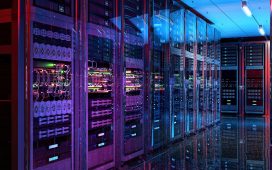Sponsored Feature Technologists have been attempting to create digital worlds since the dawn of computing. The industry has been entranced then left feeling deflated by digital environments ranging from The Sims™ to Second Life™, to virtual reality headsets, and arguably, the initial variants of the Metaverse.
But if there’s a question mark over whether we really need “new” digital worlds, there’s no doubt there are compelling reasons to build digital replicas of parts of the existing real world. Or to put it another way, to create digital twins.
Undoubtedly, the environments we build in the physical world – from retail stores, office buildings, factories or logistics centers, to smart cities – are incredibly complex. When problems arise, shutting them down while solutions are worked out and tested might be economically unfeasible or unpalatable. Even better, if problems can be spotted while they’re still on the digital drawing board, they can be fixed without causing disruption. That’s as true of an electric vehicle or medical device as it is of a theme park or car factory.
Nigel O’Leary, CEO of specialist systems integrator Dimension88, says there are typically three key elements to a digital twin. The first is prototyping – digitally creating the object – a vehicle, or hospital or power plant – so that users can see it and refine it before it is physically built, “rather than an architect building it, and then you step into it and go, ‘we gotta live with it’.”
The second part is the ability to overlay data, whether that’s a timeline, costs, or materials. “So, at the end of the process, you’ve got something that is not just a digital twin, but you’ve got the relevant information as to ‘when was this installed, who did it’ and so on.” Explains O’Leary.
The third element, he says, is deciding how you use the digital twin going forward – which may involve planning preventative maintenance or working out how to deal with potential problems. He explains, “So after you’ve got the twin, how do you run scenarios and how do things progress and work.”
Building of the digital twin of a vehicle, a manufacturing plant, or a city, is not trivial. But the challenges are about much more than just sourcing the raw compute power.
In times gone by, O’Leary explains, “You’d be building bespoke code or programs to enable collaboration.” This created fragmented, complicated pipelines, with multiple contributors using different, hard to connect tools. Moreover, the people the environments were being built to help – architects, engineers, and business owners, often lacked deep technical skills.
The demands now are even higher. As Dr. Valerio Rizzo, head of AI at Lenovo EMEA says, creating digital twins of manufacturing plants or complex infrastructure doesn’t mean just physical properties and mechanics. In the era of intelligent devices and IoT, “cognitive” properties need to be included too, with constantly updated real world data potentially being streamed into the model.
This necessitates a platform that facilitates the creation of all the components needed to assemble massive digital scenes, including props, characters, structures, and algorithms. This, in turn, requires a smooth integration of data components across diverse specialized 3D applications, simulation software and the ability to incorporate custom tools, code scripts or programming frameworks into the work processes.
A pipeline to a new world?
“The traditional way to do that was to actually import and export assets, then move the assets from one piece of software to another to finalize the development,” Rizzo explains. Everything would then be integrated into a game engine or similar environment, he says, which even then would still need further adjustment.
What is needed is an approach that can seamlessly deliver the massive compute power and ongoing data which is needed to build large scale, “industrial” digital twins. But this also has to provide the required tooling, while also simplifying simultaneous collaboration between different users, both at the building stage, and on an ongoing basis. All without breaking the workflow between the builders of the digital world, and the users who will be collaborating within it.
That’s the vision behind NVIDIA’s Omniverse Enterprise platform, which builds on the vendor’s scalable GPU development platform to help enterprises develop “physically accurate, AI-enabled, virtual simulations that are perfectly synchronized with the real world.”
The platform is built on the Universal Scene Description framework, originally developed by Pixar for animated films. Other key components underpin simulation and rendering, as well as collaboration and data integration, connectivity between third party and Omniverse applications, and the ability for users to develop their own extensions, apps, and plug-ins.
So what does it take to deliver Omniverse Enterprise? Something that spans hardware, infrastructure and services which Lenovo provides with its EveryScale OVX Solution, designed to deliver everything needed in a single package.
Unsurprisingly, the solution requires powerful underlying compute resources to support the rendering and simulations, the collaboration, and the massive datasets involved. And, according to Rizzo, this needs to be done across “as many nodes as you need, and across multiple GPUs, which is something that was impossible to do with traditional game engines.”
This is all done in a single instance, scaled across multiple servers, which means users aren’t “siloed into separate servers, but they will be together within the same scene.” says Rizzo. So, they will be effectively sharing the same “time and space in the digital space”.
The basic building block of the OVX platform is a single node box with eight GPUs, two Intel Xeon Platinum processors, and low latency NVMe storage which supports around 12 users. For groups of 20 to 40 users, four nodes can be built together into a “Pod”, packing 32 GPUs and eight Intel Xeon CPUs, and using the Spectrum 2 or Spectrum 3 high-speed network fabric. The next level up is the SuperPods packing 128 or more servers, and using the Spectrum 3 network fabric, storage and orchestration software to support 100 or more users.
The tale of the tape
EveryScale OVX is complemented by Lenovo’s ThinkStation and ThinkPad P Series, a complete end to end portfolio of NVIDIA RTX powered Workstations optimized for complex NVIDIA Omniverse Enterprise workstreams. In addition to these powerful workstations, Lenovo has an extensive portfolio of ThinkEdge AI/Edge and ThinkReality AR/VR devices designed to both capture and consume the IoT information at the edge. This information can then be streamed to the digital twin, as well as the underlying enterprise connectivity kit.
Lenovo’s Scalable Infrastructure (LeSI) framework ties it all together. Customers can buy single components and rack and stack themselves. But Pods can also be pretested and bundled together before being delivered, which Rizzo says cuts time to value and minimizes waste, specifically paper and plastic packaging waste, thus reducing its impact on the physical environment.
You might think that the cloud would provide the ideal platform for digital twinning. But as O’Leary points out, many of the end users involved in their creation are not technologists and maintain a more critical focus on simplification and collaboration. Moreover, the nature of digital twins means that many organizations will be extremely sensitive about their IP, product plans and systems as well as their physical infrastructure – residing anywhere out of their control.
By referring to a real-world situation (you can read more about Dimension88’s Meta and Omniverse Solution Integrator here), O’Leary explained how computer vision-powered robots in a logistics center had trouble accurately identifying boxes afterchanging the packaging tape. Experimenting with different types of packaging tape sounds like a minor thing, however, stopping a real world production line, whether in logistics or in manufacturing, means incurring in significative real world cost.
To solve the problem, the team created a digital twin of the packages, allowing them to simulate different scenarios and test various solutions before implementing them in the real world.
You could say, “‘Okay, so what if the tape changes again next time?'” explains Rizzo. In that instance, he continues “if they had a problem that they needed to fix, the quickest route to fix it will be to take the digital version, edit those boxes, generate multiple versions and create new synthetic data for improving the accuracy of their computer vision AI model.”
The “virtual” boxes have endless versions with different types of tape, as well as staining and other imperfections. “So the benefit of doing a digital twin, in that instance, was being able to create many more boxes and plan for the future.”
O’Leary explains, the digital twin approach means: “You’re looking for issues in your physical world, that you can overlay into the virtual and look at the options.”
For a 24×7 shipping concern, exploring multiple options in the digital twin is going to be far more palatable from a financial point of view as this approach is more cost-effective than stopping production in the physical world to address the issue. The digital twin approach helps organizations identify issues in the physical world and explore potential solutions in a virtual environment.
Sponsored by Lenovo.











